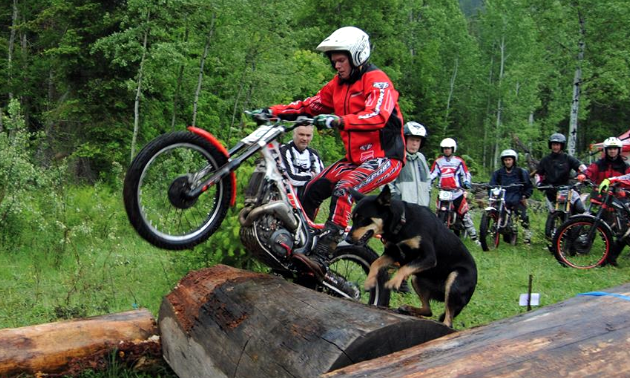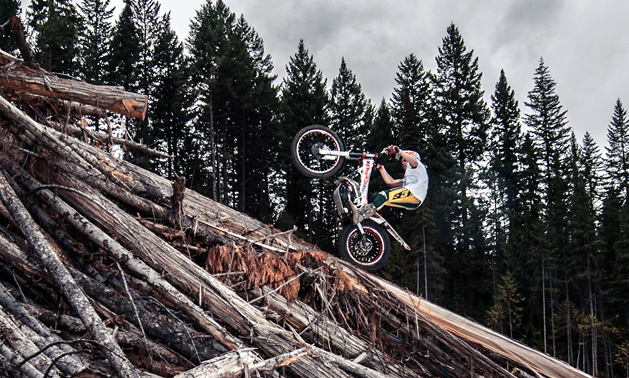Freeriding in the woods can lead to some of the best times you’ll ever experience on two wheels. Completely immersed in nature, you’re in the zone; it’s just you and the sound of your crisp pipe. Relying on faith in your own skill, you respond in time to whatever is coming up fast on the trail.
Pushing your own limits and often you’ll come to a point where you find yourself riding away from a gnarly situation, wondering how you just escaped those terrifying few moments completely unscathed. Broadening your knowledge of tricks will help you swiftly move through obstacles with confidence and limit those grim times on the bike. If you’ve ever spent time riding in the woods, you’ve more than likely come across one of nature’s road blocks with one or more fallen logs. Often, they are too big to move by hand and there is no other way around, so you have to have a red hot crack at hopping the log.
Today, I will be scratching the surface on the different techniques, tricks and tips to help navigate your way over the different size and style of logs.
I’m one of the lucky trials/moto kids. While coming up through the ranks in trials, I have competed all through Australia and Europe at a young age. I have been able to ride with all different kinds of riders, obtaining influences with style and techniques coming from all parts of the globe. Now moving into the hard off-road scene, I carry a lot of those trials techniques onto my Yamaha YZ 250FX, powered by Mountain Motorsports in Golden, B.C.
Techniques
There are many variations of riding over logs. For example, you could use the sheer power of the engine to smash ‘n’ bash your way over the log. Or, you could be aggressive with your clutch and pop the bike over using the “double blip” or what is also known as the “Jap Zap” technique. Some rely on all body, while others time their body perfectly with compression and return of their suspension, and then let the grunt of the engine do its thing to get you and the bike over.

Sam’s assistant, Tiki, appears to have the art of log hopping down pat. — photo courtesy Sam King
Just like everything in the world of moto, everybody has their unique style or different method of doing things. It will take quite the amount of seat time and experimenting with different techniques to understand the feeling of using the suspension and power in perfect unison to lift you up and over the obstacle.
Gas it
Using the sheer power of the bike to blast the engine and hop over smaller logs can often be the easiest, fastest and most energy-efficient way of hopping over logs. This is also the same technique most endurocross riders use to hit logs at full speed or to double to the next log in the matrix.
To do it, approach the log at a consistent speed in second gear (you should start slow and build your speed as you are becoming more and more comfortable with this technique). Let your front wheel smash right into the face of the log—this will compress your suspension and pop your front wheel high up into the air.
Hot Tip: It is very important to keep progressively increasing the gas through the entire log as you are now at a critical couple of milliseconds in this technique. If you were not on the gas and “holding pressure” through the rear wheel, it is very likely you will be bucked over the front of your bike.

The idea of this technique is to get a little bit of air time once your rear wheel has smashed into the log. — photo courtesy Sam King
Keep steady on the throttle and imagine yourself wheeling your rear wheel into the face of the log as hard as you possibly can. This will balance out your bike and now your front wheel should return to the same height as your rear wheel is in the air. For all the skaters out there, imagine yourself using the log to make your bike do an “ollie.”
Double blip
Starting off slow in first gear, position yourself towards the back end of the bike but standing on your pegs. Lightly preload the front end by pushing your upper body weight down through the forks, and, as the suspension is returning, progressively but surely open the throttle from basically idle all the way to half throttle. This will lift your front wheel off of the ground and into the face of the log. This is what we call the first “blip” or the “jap.”
It is very important to know where to place your front wheel on the face of the log. How high or low you hit your front wheel determines how much pop or lift you can achieve. I typically aim to place my front wheel about three-quarters of the height of the log, but this can also vary slightly on the size or shape of the log.
Now as your front forks have fully compressed and start to return, you need to give it the second “blip” or the “zap” part of the technique. It is very important that you get the timing perfect for that second blip as this part of the motion is what gets your rear wheel up and on top of the obstacle. Imperfect timing will most likely just put you on the sump plate of your bike, which is not a high consequence failure but will let you know that you still need to work on your “blips” and “zaps.”
It’s not easy to get the rear wheel to come right off the ground and onto the log. It takes a mixture of perfect throttle timing with your suspension as well as a big explosive effort with your legs just as you give the bike the second “blip.” To hold pressure on the rear wheel, lean back and hang your body weight over the rear end of the bike. Once you are up on the log, it is very important to keep traction; this is what keeps your forward momentum and also carries your front wheel safely to the ground on the far side of the log, instead of going over the hangers.
Hot Tip: Wondering when to start the wheelie when placing your front wheel into a log? As a general rule of thumb (not law), the distance from the ground to the height of your target you are aiming for on the log (three quarters of the height of the log) is roughly the same distance back from the log that you would lift your front wheel from the ground into the log from the obstacle back towards the rider.
Clutch it
Note: I would strongly recommend perfecting the standard throttle “double blip” before adding in the clutch technique. Once you’re able to confidently find the feeling of getting the rear wheel to lift off the ground and hit into the log, then I would start trying to use the clutch to get even more lift.
Using the clutch to pop the wheelie into the log can be a challenging task to get the grips of. It takes a lot of practice to perfectly time the reaction of your suspension with your engine and body.
To use the clutch in your double blip is how you can achieve even more lift from your bike, and it actually makes the motions happen a little faster.
So, instead of performing the double blip with your throttle hand, you can just keep a steady throttle adjusted according to the size of the obstacle. Slip the clutch once your front wheel has hit the obstacle and let the engine load up while your suspension is compressing and then, all in one explosive effort, you can let the clutch out as your body is helping the bike to hop and lift on to the log.
Hot Tip: Something I do for every action I take on my bike is to consciously lock my core before I approach the obstacle. This is a way to become more sturdy on the bike and it will help you maintain your balance once you are holding pressure on the rear wheel.
Now that you know the fundamentals, it’s time to get out there and ride! Not only will log hopping help you out on trails but now you can start to apply the double blip technique to other obstacles, like rocks or creek and river banks.
Keep an eye out for a tutorial video demonstrating all of the above.







Comments